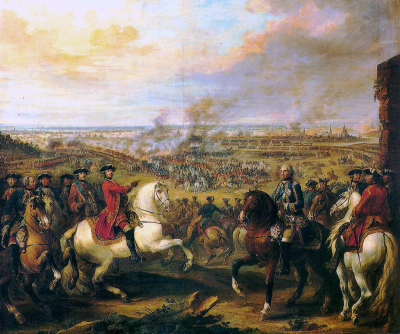The Battle of Toulon or Battle of Cape Sici took place on 2223 February 1744 (NS) in the Mediterranean off the French coast near Toulon. A combined Franco-Spanish fleet engaged Britain's Mediterranean Fleet. The French fleet, not officially at war with Great Britain, only joined the fighting late, when it was clear that the greatly outnumbered Spanish fleet had gained tactical control of the battlefield. With the French intervention, the British fleet was forced to withdraw.In Britain the battle was regarded as the most mortifying defeat; the Franco-Spanish fleet successfully ended the British blockade and inflicted considerably more damage to the British than they received, causing the British to withdraw to Menorca in need of extensive repairs to the fleet. The retreat of Admiral Mathews' fleet left the Mediterranean Sea temporarily under Spanish control, allowing the Spanish navy to deliver troops and supplies to the Spanish army in Italy. This decisively swung the war there in their favour.Thomas Mathews was tried by court-martial in 1746 on charges of having brought the fleet into action in a disorganised manner, of having fled the enemy, and of having failed to bring the enemy to action when the conditions were advantageous. He was one of seven ship captains dismissed from service.In English-language literature, the battle is viewed as indecisive at best and a fiasco at worst.
The War of the Austrian Succession (German: Österreichischer Erbfolgekrieg) was the last great power conflict with the Bourbon-Habsburg dynastic conflict at its heart. It occurred from 1740 to 1748 and marked the rise of Prussia as a major power. Related conflicts included King George's War, the War of Jenkins' Ear, the First Carnatic War and the First and the Second Silesian Wars.
The pretext for the war was Maria Theresa's right to inherit her father Emperor Charles VI's crown in the Habsburg Monarchy, but France, Prussia and Bavaria really saw it as an opportunity to challenge the Habsburg power. Maria Theresa was backed by Britain, the Dutch Republic and Hanover, which were collectively known as the Pragmatic Allies. As the conflict widened, it drew in other participants, among them Spain, Sardinia, Saxony, Sweden and Russia.
There were four primary theatres of the war: Central Europe, the Austrian Netherlands, Italy, and the seas. Prussia occupied Silesia in 1740 and repulsed Austrian efforts to regain it, and between 1745 and 1748, France conquered most of the Austrian Netherlands. Elsewhere, Austria and Sardinia defeated Spanish attempts to regain territories in Northern Italy, and by 1747, a British naval blockade was crippling French trade.
The war ended with the Treaty of Aix-la-Chapelle (1748) by which Maria Theresa was confirmed as Archduchess of Austria and Queen of Hungary. The treaty reflected that stalemate since most of the commercial issues that had led to the war were left unresolved, and many of the signatories were unhappy with the terms. Although the war had nearly bankrupted the state, Louis XV of France withdrew from the Low Countries for minimal benefit, to the dismay of France's nobility and populace. The Spanish considered their gains in Italy inadequate since they had failed to recover Menorca or Gibraltar and viewed the reassertion of British commercial rights in the Americas as an insult.
Although Maria Theresa was acknowledged as her father's heir, she did not consider that a concession and deeply resented Britain's role in forcing her to cede Silesia to Prussia. For British statesmen, the war demonstrated the vulnerability of George II's German possession of Hanover to Prussia, and many politicians considered they had received little benefit from the enormous subsidies paid to Austria.
The result was the realignment known as the Diplomatic Revolution in which Austria aligned itself with France, which marked the end of their centuries-old enmity, and Prussia became an ally of Britain. The new alliances fought the Seven Years' War in the following decade.

 English
English  español
español  français
français  português
português  русский
русский  العربية
العربية  简体中文
简体中文 
